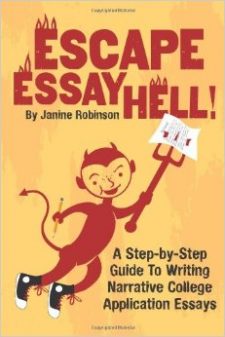URGENT UPDATE!
The University of California CHANGED its essay prompts for 2016-17.
Learn about the all-new requirements by clicking HERE!
THIS POST IS OUTDATED!
How to Describe a Place
in a College App Essay
If you are applying to the University of California, you need to write two college application essays.
I wrote about how to Describe the World You Come From three years ago, explaining how to think about the first prompt and brainstorm ideas for your essay.
It would help you to read that advice first, then come back.
This time, I want to give you some ideas on how to SHOW the world you decide to write about when describing the setting of your world.
Since in the UC essay your world will be some type of community, I believe you might need to describe where you experienced it. In writing, that’s called the setting.
If you want a powerful essay, you will use descriptive language, sensory details and specific examples to help us see your world.
You can either explain your world, or show it to us. If you show it to us—help us see and experience it along with you—we will find it much more interesting!
And chances are, if we find your world interesting, we (colleges!) also will find you interesting.
I recently discovered a wonderful short writing guide by James Thayer, who does one of the best jobs of teaching how to “show” in writing.
He has one section just about how to show The Setting. (You can download Show or Tell? A Powerful Lesson on a Crucial Writing Skill on Amazon for less than a buck. If you want the golden key to great writing–including your college admissions essays–take ten minutes and read this gem!).
Here are some of his examples of how to Show your setting/world/place instead of simply explaining it (Tell). I’m going to bold the sensory details that help you see, hear, smell and feel the settings.
Also, notice how Thayer also includes some action (things happen) to describe these places, using strong verbs.:
Tell: Rob’s bedroom was a mess.
Show: Rob kicked aside two empty Coke bottles, and swatted an empty pizza box off on his bed. He pushed aside a pile of shirts, then sat down.
* * *
Tell: The forest was gorgeous in the autumn.
Show: Aspen leaves had fallen, covering the forest floor in gold.
* * *
* * *
Tell: The house was stark and uninviting.
* * *
In his book, Thayer has examples of how to SHOW other parts of writing, which could help you bump up your narrative essay–ranging from showing weather, aches and pains, how people look, reactions, personality and emotions. Did I mention it’s only 99 cents?
Here’s Thayer’s brilliant way to tell the difference between showing and telling:
“What’s the difference between these two sentences?
His arm itches.
He scratched his arm.
The difference is profound, and knowing it will instantly make someone a better writer.”
(In case you are still confused, “His arm itches” is telling and “He scratched his arm” is showing.)

















Hi, my essay (for UC- world prompt) is about my passion for writing. I open up with a description of my desk, and from there I discuss what I have done to cultivate my interest in writing, why I love writing, and what I want to do in the future. Is that a sufficient answer? Also, I feel like I show a lot in my opening, but tell mostly afterwards. Do you have any tips on how to show (rather than tell) the experience of writing.